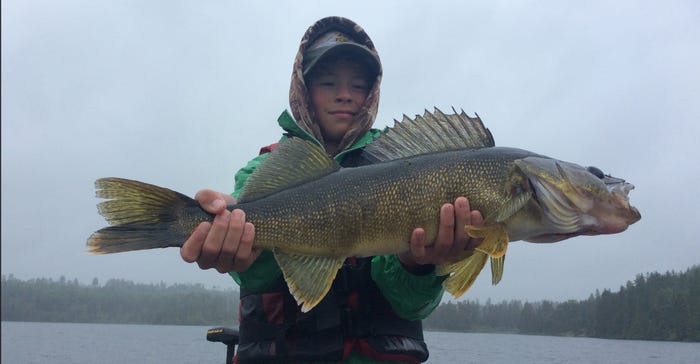April 20, 2020

Every year, some Kansas farmers head north to catch arm-long Canadian walleye and fat, acrobatic smallmouth bass that clear the water by a yard or better. Others head to Mexico for trophy largemouth bass.
A few head to giant rivers to catch gargantuan catfish. Some stay closer to home, head to Milford Reservoir and key on wipers that crush top-water lures.
With Leonard Jirak’s help, they could do any of the above on their own property. Jirak, of rural Burlington, owns Trophy Fisheries. He can help make private fisheries so good that everyday seems like the proverbial “yesterday.”
Jirak spent 38 years as an innovative fisheries biologist with the Kansas Department of Wildlife and Parks. His private venture is about 25 years old.
Special species
Creating a five-star fishery is easiest if it begins before a private impoundment is built.
“Would you hire an architect after you built a house?” Jirak says. “It’s always easier to construct something right than it is to fix it later.”
One of his largest priorities is ensuring good water clarity.
The next best thing is a new pond that hasn’t been stocked or one that’s been drained and had all fish removed.
Here are some of the species he’s helped landowners enjoy:
Wipers. These savage hybrids between white bass and striped bass have been popular in Kansas’ public waters for 30 years or more. Their willingness to maul about any kind of bait can make you think twice about dangling your toes in the water.
Artificial feeding is the only way for wipers to survive, or at least grow, in private waters. Jirak’s fish are trained to eat pellets before stocking. Wipers from 4 to 8 pounds are common. Flint Oak, the high-end sporting resort in Elk County, has produced wipers to 16 pounds. My best-ever of 11 pounds was caught there.
Walleye. The foggy-eyed fish can do well in ponds and reach up to 8 pounds. They’re a great predator for controlling crappie populations. Walleye need to be stocked before any other predatory fish. Reproduction can occur but it’s rare.
Smallmouth bass. America’s most acrobatic black bass can do well if stocked early in some private impoundments with good water clarity. Smallmouths of 3 to 4 pounds aren’t uncommon.
Bluegill. Many ponds use bluegill as an important forage fish for bass and walleye. Feeding bluegill pellets can grow them to impressive sizes. Such a feeding program can have hybrid bluegill growing to the size of $20 ribeyes. They’re a perfect fish to have grandkids squealing with joy every trip to the water.
Catfish. Jirak made 20-pound channel cats common in public waters during his days as a state biologist. Management programs can produce blue cats or channel cats to 30-plus pounds.
“Nothing is better to feed than catfish. For every 2 pounds of fish food, you get back 1 pound of catfish,” Jirak says. “There’s certainly no livestock with that return.”
Catfish can be added to an impoundment with existing fish populations. It’s important they not be below 10 or 12 inches long when stocked. Anything smaller can be very expensive food for larger fish.
Maintaining quality
Some common problems and questions Jirak hears from private pond owners include:
Existing bass populations. The most common question Jirak hears from private pond owners is how to grow bigger largemouth bass in existing ponds. His answer is predictable — remove some fish so others have the room and food needed to grow.
“I tell people to catch 25 bass, measure them, and write those measurements down,” Jirak says. “List them from biggest to smallest and draw a line right through the average. Everything below the line needs to be taken out. A pond is only capable of producing so many pounds of bass. That can be 200 half-pounders or 20 5-pounders. It’s the same thing.”
With steady harvest and good habitat, anglers could see a 2-inch improvement in average sizes within a year.
Crappie. Jirak says underharvesting crappie is another common problem because they’re so prolific. If they’re to be stocked, black crappie are preferred because they’re not as prolific as white crappie. Still, a steady harvest is needed.
Grass Carp. Jirak recommends caution when stocking the vegetarian fish into ponds. Too often they remove too much aquatic vegetation, which is important fish habitat. His recommendation is 10-12 fish per acre of problematic weeds. For example, if a 12-acre pond has 2 acres of aquatic weeds, it would get 20 to 24 grass carp.
Fathead Minnows. Jirak disagrees with the popular method of using minnows as a food source.
“The conversion rate is only about 1 pound added to game fish for every 10 pounds of minnows,” he says. “Most times all the minnows are eaten before you make it home.”
Jirak can be reached at [email protected].
Pearce writes from Lawrence.
You May Also Like




